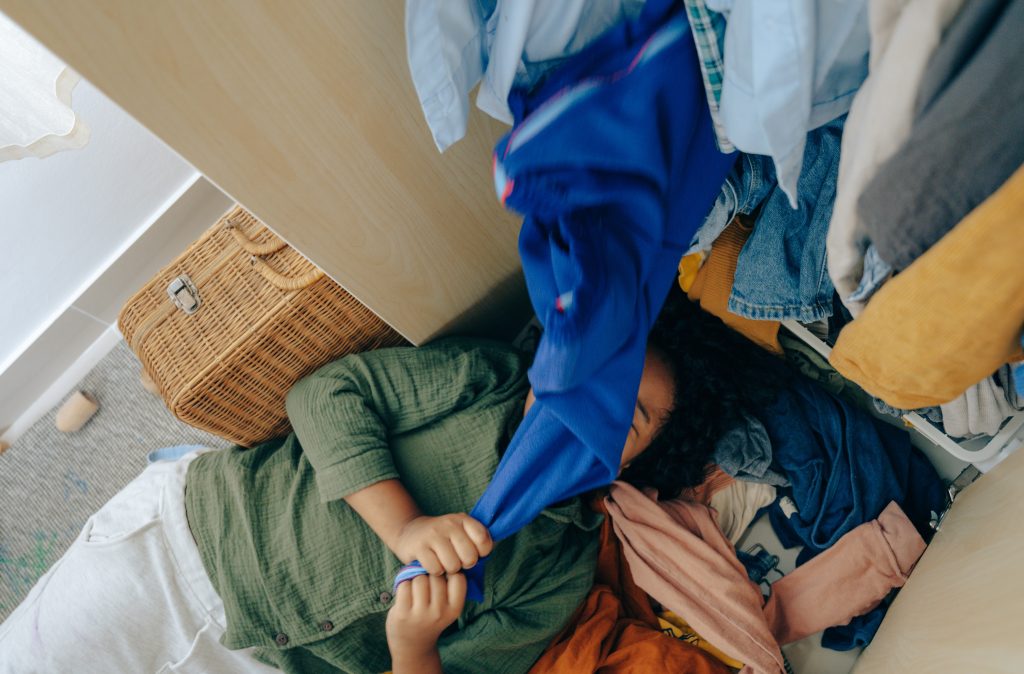
When it comes to dressing children, safety should be one of the top priorities for parents. From the materials used in clothing to the way garments fit, choosing the right clothes for your child can help avoid potential hazards and ensure comfort throughout the day. In this article, we’ll guide you through essential factors to consider in your child’s wardrobe to help keep them safe, comfortable, and happy.
1. Fabric Safety: Choosing the Right Materials for Kids
The fabric of your child’s clothing plays a crucial role in their overall comfort and safety. Choosing the right materials can help prevent skin irritation, overheating, and allergic reactions.
a. Soft and Breathable Fabrics
Children have delicate skin, and the clothes they wear should be gentle on it. Look for fabrics that are soft, breathable, and kind to sensitive skin:
- Cotton: Cotton is one of the best choices for children’s clothing. It’s soft, breathable, and absorbs moisture, keeping your child comfortable throughout the day. Organic cotton, which is free from harsh chemicals, is an even better option for babies and toddlers.
- Bamboo Fabric: Bamboo is another soft and hypoallergenic material. It’s moisture-wicking, naturally antibacterial, and often gentler on the skin than synthetic fabrics.
- Cotton Blends: Cotton blends (e.g., cotton with polyester or spandex) can offer added stretch, making clothes more comfortable without sacrificing durability.
Avoid fabrics that could irritate your child’s skin, such as:
- Synthetic Fabrics: While synthetic fabrics like polyester or nylon are durable, they can trap heat and moisture, causing discomfort. Some children may also be allergic to synthetic materials, leading to rashes or irritation.
- Wool and Rough Fabrics: While wool is warm, it can be itchy and irritating for children with sensitive skin. If you choose wool, look for softer varieties or blend it with other materials to reduce discomfort.
b. Flame-Resistant Fabrics
Some children’s clothes, especially sleepwear, are required by law to meet flame-resistant standards. Make sure to check for labels that indicate flame-resistant fabrics, which can help protect your child in case of an accidental fire. While flame-retardant treatments are common, they can wear off after several washes, so it’s important to follow care instructions and replace worn-out items.
2. Proper Fit: Ensuring Comfort and Safety
A proper fit is just as important as the fabric when it comes to kids’ clothing safety. Ill-fitting clothes can cause discomfort, restrict movement, or even present a choking hazard.
a. Avoid Clothes That Are Too Tight
Tight clothing can cause discomfort and even interfere with circulation. Be cautious of garments like tight waistbands, elastic cuffs, or restrictive seams that can dig into your child’s skin. Opt for items with adjustable waistbands, drawstrings, or stretchy materials that allow for flexibility and growth.
- Tight Shoes: Ensure shoes fit well, as tight shoes can lead to blisters, foot pain, or deformities. Properly fitted shoes help support your child’s growing feet and encourage healthy development.
- Necklines: Avoid clothing with tight necklines, particularly for younger children and babies. Tight shirts or dresses around the neck can be uncomfortable and may restrict airflow. Opt for clothes with stretchy or relaxed neck openings, or choose clothes with zippers or buttons that are easy to open.
b. Loose Clothing Hazards
While too-tight clothes are a problem, overly loose clothing can present a different set of risks. For example, clothing with long strings, scarves, or oversized items can get caught in playground equipment, bicycle chains, or escalators.
- Avoid Drawstrings: Drawstrings can be a serious choking or strangulation hazard for children. Many clothing manufacturers have moved away from drawstrings in kids’ clothing for this reason. Be mindful of this risk, especially with hoodies, pants, and jackets.
- Consider Adjustable Fits: Adjustable straps or waistbands (e.g., Velcro, snaps, or stretchy bands) are a safer option for clothing that needs to grow with your child. They allow for a more comfortable fit without the risk of loose ties or strings.
c. Proper Shoe Fit
A proper shoe fit is essential for ensuring your child’s safety and comfort. Shoes that are too small can cause blisters, pain, and even permanent foot damage, while shoes that are too large can make walking difficult and increase the risk of trips and falls.
- Measure Feet Regularly: Children’s feet grow quickly, so be sure to measure their feet regularly. Avoid buying shoes that are too big, thinking your child will “grow into them.” Instead, ensure there’s about a half-inch of space between the tip of the shoe and your child’s longest toe.
- Proper Support: Choose shoes that provide adequate support and cushioning. For active kids, opt for sneakers with arch support, a solid heel counter, and a non-slip sole to promote stability.
3. Safety Features in Clothing: Added Protection for Your Child
In addition to fabric and fit, certain safety features can make children’s clothing more protective and functional for daily activities.
a. Reflective Elements for Visibility
If your child will be walking or biking to school or playing outdoors in low-light conditions, consider clothing with reflective elements. Reflective stripes or logos on jackets, backpacks, or hats can improve visibility and help your child stay safe in traffic or during evening play.
b. Non-Toxic Dyes and Paints
Be cautious when purchasing clothing with bright colors, prints, or embellishments. Some garments may contain dyes, paints, or other chemicals that can irritate your child’s skin or even be harmful if ingested (e.g., if the child sucks on clothing). Look for clothes that are labeled as “lead-free” or “non-toxic,” especially for younger children who tend to explore the world with their mouths.
- OEKO-TEX Standard: Clothing with this label meets rigorous safety standards for harmful substances. It’s a good indicator that the garment is safe for your child’s skin.
c. Avoiding Small Parts and Decorations
Children, especially babies and toddlers, are prone to putting things in their mouths. Always check for any loose buttons, beads, or decorations on clothing that could present a choking hazard. Clothing with these elements should be avoided for younger children who are still learning to explore their environment safely.
4. Care and Maintenance: Keeping Clothes Safe After Purchase
Once you’ve selected safe clothing for your child, it’s important to properly care for it to ensure it remains safe, clean, and effective.
a. Regular Washing
Regular washing is essential for removing dirt, bacteria, and allergens from your child’s clothes. Always follow the care instructions on clothing tags to ensure you’re washing clothes at the proper temperature and using the right detergent.
- Non-Allergenic Detergents: If your child has sensitive skin, use hypoallergenic detergents that are free of fragrances, dyes, and harsh chemicals.
- Avoid Fabric Softener: Fabric softeners can leave a residue on clothing, which can cause irritation for sensitive skin. Instead, choose a mild, unscented detergent and opt for natural alternatives like vinegar or baking soda for softening.
b. Inspect Clothes for Wear and Tear
Regularly inspect your child’s clothes for damage, such as loose seams, buttons, or threads. Over time, fabrics can become worn down, creating potential safety hazards. Repair or replace items as needed to keep your child’s clothing safe.
Conclusion
Ensuring your child’s clothing is safe involves considering fabric choices, proper fit, safety features, and regular maintenance. Prioritizing comfort and functionality while also looking for clothing that promotes safety is key to creating a wardrobe that will keep your child happy, healthy, and safe throughout the day. By following these tips, you can feel confident that your child’s clothing is both stylish and secure, providing them with the protection they need while they grow and explore the world around them.
